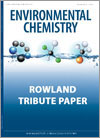
Environmental Chemistry
Volume 10 Number 4 2013
EN13061Perspectives on our planet in the Anthropocene
Environmental context. The term Anthropocene has been proposed as a name for the present geological epoch in recognition of the recent rise of humans to being a geophysical force of planetary importance. This paper provides an overview of humanity’s global impact in terms of population, energy and food demands, climate, air and ocean pollution, biodiversity and erosion, before giving a perspective on our collective future in the Anthropocene.
EN13021Is site preference of N2O a tool to identify benthic denitrifier N2O?
Environmental context. The greenhouse gas nitrous oxide is produced by bacteria and emitted from terrestrial and aquatic environments; the origin of this compound can be determined by its 15N intramolecular distribution (site preference). The site preference of nitrous oxide was characterised experimentally in bacterial denitrifying communities under controlled conditions. This study shows the importance of the last step of denitrification on the site preference values, and that complementary methods are necessary to identify the sources of nitrous oxide.
EN13010Arsenic binding to organic and inorganic sulfur species during microbial sulfate reduction: a sediment flow-through reactor experiment
Environmental context. The use of water contaminated with arsenic for drinking and irrigation is linked to water and food borne diseases throughout the world. Although reducing conditions in soils and sediments are generally viewed as enhancing arsenic mobility in subsurface environments, we show they can actually promote As sequestration in the presence of reduced sulfur species and labile organic matter. We propose that sulfurisation of organic matter and subsequent binding of As to thiol groups may offer an innovative pathway for As remediation.
EN12194Size-resolved elemental composition of aerosol particles in greater Sydney in 2002–2003
Environmental context. Atmospheric aerosols may either scatter or absorb solar radiation, potentially cooling or warming the planet. The warming–cooling effects of aerosols are determined by their optical properties, which depend on chemical composition. To better predict aerosol effects we need a good understanding of aerosol chemistry across a wide size range and geographic area. We report results of a study designed to increase understanding of the chemical composition of fine and coarse aerosols in Sydney.
EN12202Agglomeration and dissolution of zinc oxide nanoparticles: role of pH, ionic strength and fulvic acid
Environmental context. The number of nano-enabled products reaching consumers is growing exponentially, inevitably resulting in their release to the environment. The environmental fate and mobility of nanomaterials will depend on their physicochemical form(s) under natural conditions. For ZnO nanoparticles, determinations of agglomeration and dissolution under environmentally relevant conditions of pH, ionic strength and natural organic matter content will provide insight into the potential environmental risk of these novel products.
EN13001Aggregation kinetics and surface charge of CuO nanoparticles: the influence of pH, ionic strength and humic acids
Environmental context. The high demand and use of nanomaterials in commercial products have led to increased concerns about their effect on the environment and human health. Because CuO nanoparticles are widely used in several products, it is necessary to understand and predict their behaviour and fate in the environment. We report a study on the aggregation and surface charge of CuO nanoparticles under environmentally relevant conditions to better predict the mobility and bioavailability of these materials in natural waters.
EN12199Evaluation of centrifugal ultrafilters for size fractionation of total mercury and methylmercury in freshwaters
Environmental context. Although mercury associated with colloids is an important part of the aquatic Hg cycle, there is currently no fast and reliable method to separate complexes smaller than traditional filter pore sizes. We test commercially available centrifugal ultrafilters for their applicability to size fractionation of total Hg and methylmercury in freshwaters. Although contamination of ultrafilters by organic matter precludes their use for fractionation of inorganic Hg, the approach proved to be very suitable for methylmercury fractionation regardless of sample organic matter content.
EN13052Solution-state NMR investigation of the sorptive fractionation of dissolved organic matter by alkaline mineral soils
Environmental context. Dissolved organic matter plays a key role in global carbon cycling and environmental contaminant transport. We use one- and two-dimensional solution-state nuclear magnetic resonance spectroscopy to characterise dissolved organic matter before and after binding to alkaline subsoils with low organic carbon content. The results show that the dissolved organic matter is selectively fractionated through preferential binding of specific organic carbon functional groups.
EN13020A radio-isotopic dilution technique for functional characterisation of the associations between inorganic contaminants and water-dispersible naturally occurring soil colloids
Environmental context. The fate and behaviour of inorganic contaminants are dominated by soluble complex formation and interactions with naturally occurring colloids. Although the importance of these interactions has long been debated, our understanding of the mobility and bioavailability of contaminant–colloid associations has been hampered by the limitations of common operationally defined analytical techniques. The method developed in this study facilitates a step forward from operationally defined characterisation of the association between contaminants and colloids to a functional characterisation in terms of their exchangeability and potential bioavailability.
EN13901Early history and rationale for outdoor chamber work at the University of North Carolina
Environmental context. Imagine in 1968 having to tell the largest cities in the US that they would have to spend billions of dollars to reduce human exposure to a gas in their air that no one emitted and that no one knew for sure how it came to be there. This history recalls how scientists and policy makers met this challenge so that by 1985 effective programs were in place.



